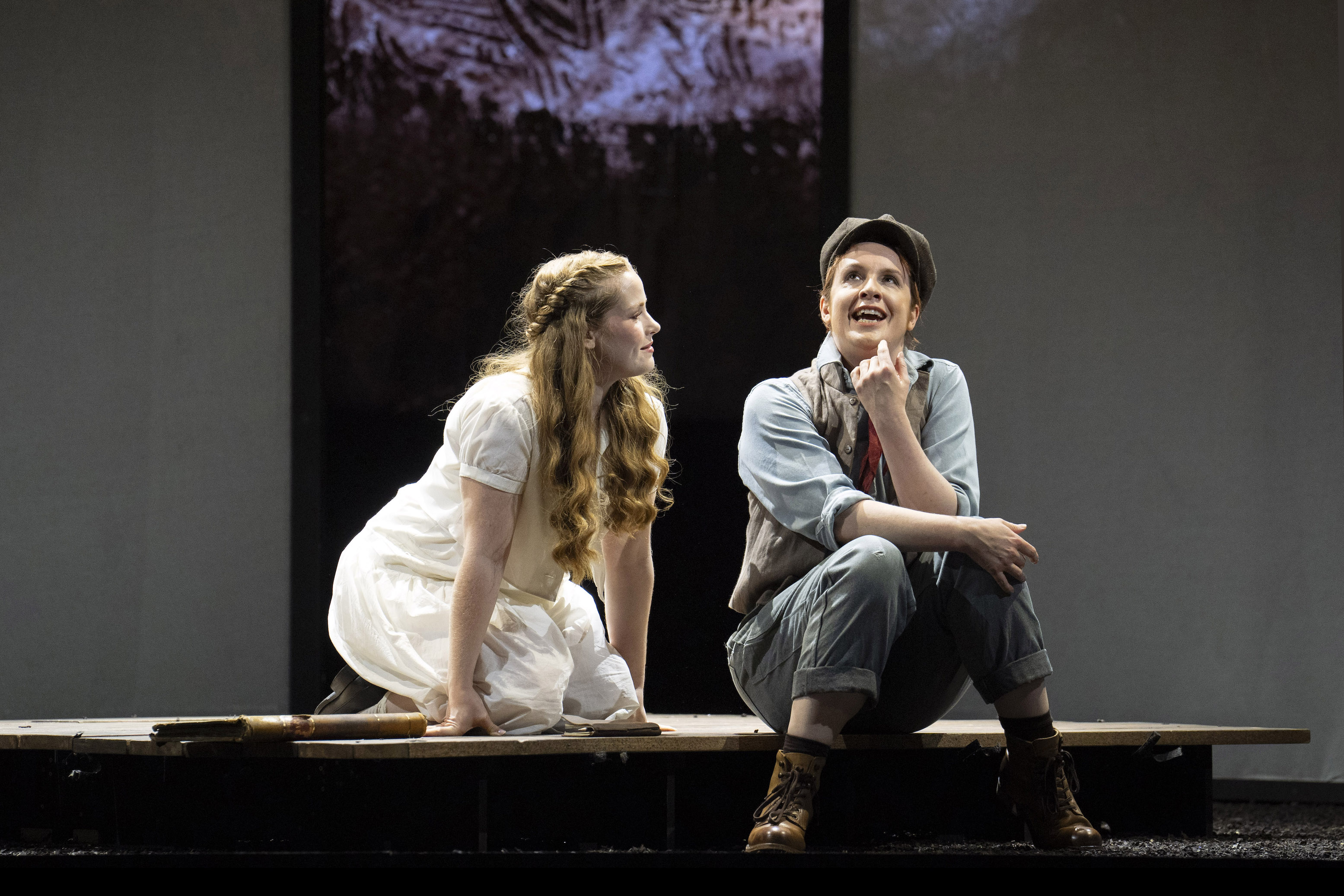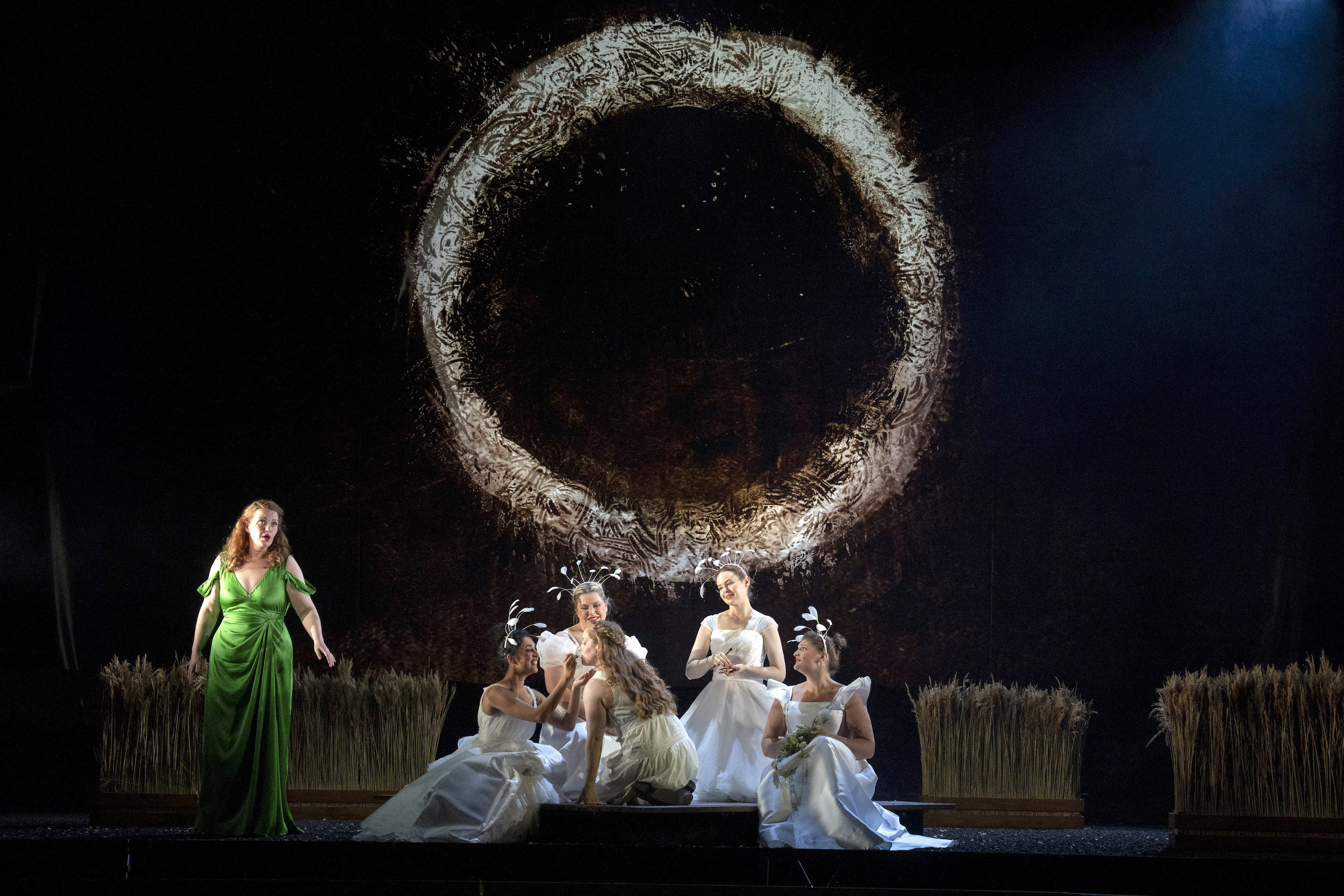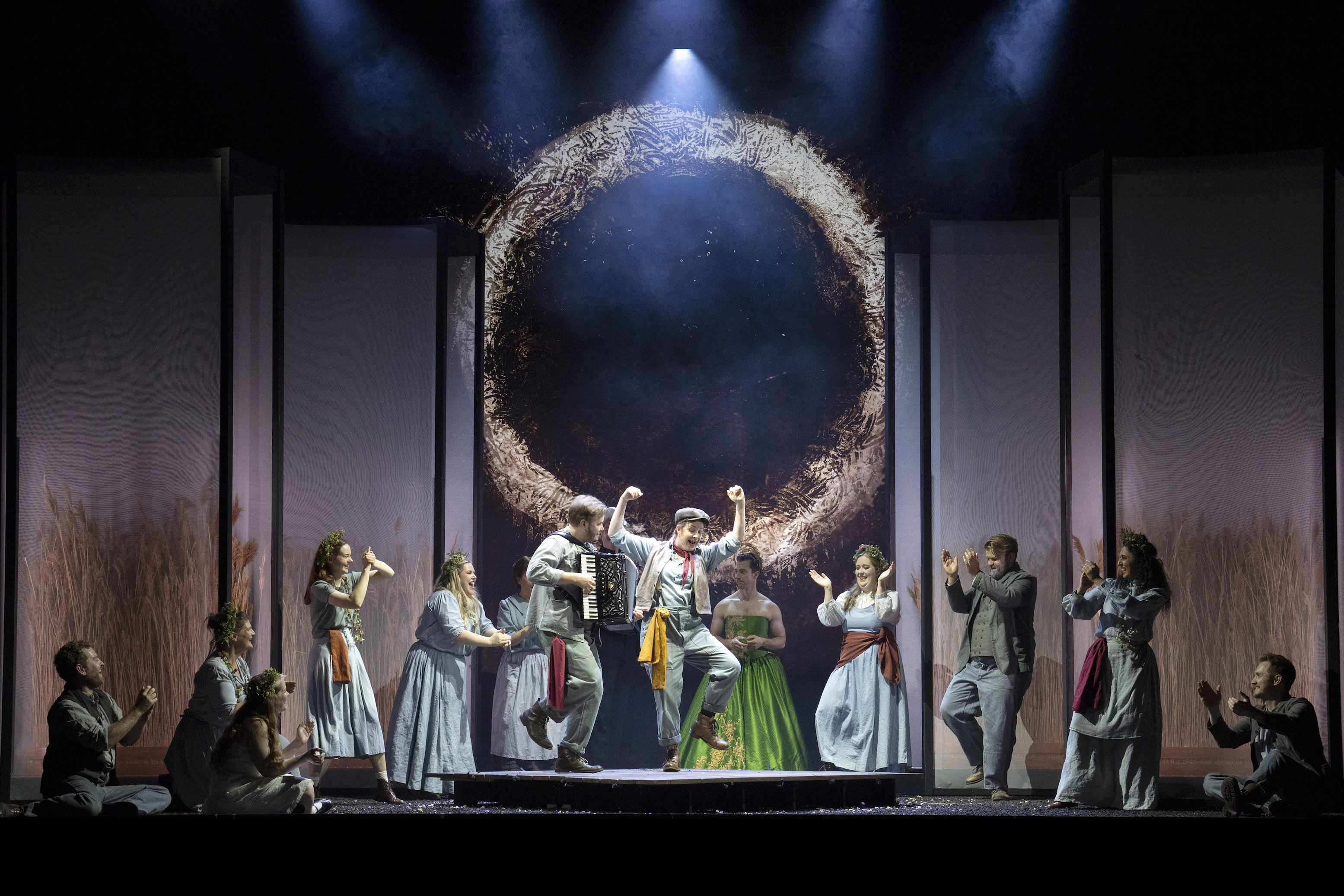Just as the first autumn chills began to grip, English Touring Opera rolled into Hackney Empire with a reminder that the sun – “god of love and life” – will eventually return. But at what price of suffering and sacrifice? Rimsky-Korsakov’s third opera, premiered in 1882, The Snowmaiden overflows with abundant musical riches – you can’t really miss the musical debt the composer’s star pupil, Stravinsky, owed his master – as it ambitiously seeks to balance fantasy and humanity in its fairy-tale of an ice princess thawed by mortal passion.
Yet its mythic, and exotic, aspects make The Snowmaiden (Snegurochka in the original Russian) a tricky proposition for a touring company on a modest budget who must run a tight, mobile ship with a pretty minimal crew. Occasionally, the demands of the piece do stretch the resources director Olivia Fuchs has at her disposal. However, savoury Russian flavours from conductor Hannah Quinn and her compact orchestra, plenty of ingenious staging and a handful of attractive performances – led by a stand-out turn from mezzo Kitty Whately (pictured below, right, with Ffion Edwards) – should melt all but the flintiest hearts. This treasure-packed score deserves to be disseminated far and wide, and ETO spreads its available wealth with commitment and some style.  For better or worse, there’s little room for barbaric theatrical grandeur here. Eleanor Bull’s functional set features an array of moveable screens backed a single mighty ring of changing light: the cycle of the seasons as cold retreats and warmth floods in underpins this fable’s every twist. Glimpses of growing crops and bundled sheaves under the hoop of fire suggest the outcome of the sowers’ dance we see. Jamie Platt’s lighting tracks the slow end of grey winter and the hard-won return of green spring, then golden summer. A small but ever-busy ensemble of chorus-dancers act as country folk whose company and kinship the Snow Princess (as the text calls her) begins to crave.
For better or worse, there’s little room for barbaric theatrical grandeur here. Eleanor Bull’s functional set features an array of moveable screens backed a single mighty ring of changing light: the cycle of the seasons as cold retreats and warmth floods in underpins this fable’s every twist. Glimpses of growing crops and bundled sheaves under the hoop of fire suggest the outcome of the sowers’ dance we see. Jamie Platt’s lighting tracks the slow end of grey winter and the hard-won return of green spring, then golden summer. A small but ever-busy ensemble of chorus-dancers act as country folk whose company and kinship the Snow Princess (as the text calls her) begins to crave.
In the pit, Quinn directs a chamber-sized band who idiomatically channel the folksier-than-Wagner leitmotifs that identify the characters. Flutes, clarinets, cello and bassoon all please, even if relatively slender forces mean that spectacular numbers such as the Tumblers’ Dance inevitably feel subdued. Quinn, though, effectively evokes the snap, swirl and pulse of the airs and dances with which Rimsky-Korsakov invokes Russian folk melody and the distinctly non-classical time signatures that carry it (11/4 at one point). Neither players nor dancers sounded or looked wrong-footed. They made up in accent and atmosphere what they lacked in weight of numbers or depth of sound.  The ice-hearted daughter of an ill-advised fling between Edward Hawkins’s brollied-and-bowlered Grandfather Frost, and Hannah Sandison’s green-draped Spring Beauty (pictured above), Ffion Edwards’s Snow Princess learns about human love from books. But she will dissolve if the sun’s passionate warmth touches her. Still she falls, first for Kitty Whately’s troubadour scamp Lel (written as a breeches role), then, after the intervention of good Tsar Berendey, for the visiting moneybags merchant Mizgir (Edmund Danon), who forsakes the village good-time gal Kupava (Katherine McIndoe). Exposure to love’s scorching sun must bring about the extinction of the maiden, a sort of virtuous vampire – even if, in Fuchs’s revisionist reading, that may mean more of a spiritual rebirth than actual puddle-forming deliquescence. All the while, Alisdair Middleton’s nimble, often witty, English libretto exults in patter numbers and acrobatic rhymes. They tend to push the fairy-tale into panto territory. It’s great fun, and always dextrous – but some passages cried out for a bit more eerie gravity.
The ice-hearted daughter of an ill-advised fling between Edward Hawkins’s brollied-and-bowlered Grandfather Frost, and Hannah Sandison’s green-draped Spring Beauty (pictured above), Ffion Edwards’s Snow Princess learns about human love from books. But she will dissolve if the sun’s passionate warmth touches her. Still she falls, first for Kitty Whately’s troubadour scamp Lel (written as a breeches role), then, after the intervention of good Tsar Berendey, for the visiting moneybags merchant Mizgir (Edmund Danon), who forsakes the village good-time gal Kupava (Katherine McIndoe). Exposure to love’s scorching sun must bring about the extinction of the maiden, a sort of virtuous vampire – even if, in Fuchs’s revisionist reading, that may mean more of a spiritual rebirth than actual puddle-forming deliquescence. All the while, Alisdair Middleton’s nimble, often witty, English libretto exults in patter numbers and acrobatic rhymes. They tend to push the fairy-tale into panto territory. It’s great fun, and always dextrous – but some passages cried out for a bit more eerie gravity.
Fuchs softens the folkloric harshness of the maiden’s semi-forced seduction away from the shape-shifting singer Lel to the crudely masculine, and violent, Mizgir. Her Jungian approach to the heroine’s life-journey also blurs hints of ritual savagery and human sacrifice: Rimsky’s apprentice would place that element centre-stage when, a generation later, he came to transform similar folk-myths into The Rite of Spring. Here, the night of merrymaking and mating ordained by the Tsar (pictured below) feels closer to the carnival nocturnes of A Midsummer Night's Dream. As for Joseph Doody’s Tsar in drag – a fine emerald ball gown – we grasp that gender fluidity may forge a bond between the lonely ruler, who fears his subjects have turned cold, and the solitary Snowmaiden. Both ice-hearted girl and cross-dressing prince appear as outsiders to conventional coupling. Yet it’s one of those directorial wheezes that takes up too much stage oxygen: when he does sing, beautifully, of his emotional isolation, the Tsar simply remembers the “golden youth” he has lost.  Although it’s hard to overlook Doody’s fancy frock, his elegant tenor has a refined range that lent the Tsar a more orthodox kind of authority. As the princess, Edwards could sound strained at the top in her earlier numbers, but grew in scope and impact, just as the character does. Her final apotheosis, a kind of sun-struck Liebestod, had all the radiant glamour the magical denouement needs. However, it was Whately’s Lel who captured musical hearts, just as she/he cheekily seduces the village girls with songs. Charm, confidence and purity of tone made this a performance to light up the darkest autumn evening. Kupava’s rustic, rather coarser, part needs robust peasant earthiness, and got it from McIndoe’s powerful, characterful, even slightly harsh, soprano. She managed the (justified) rage and petulance well as this purely human girl finds herself confusingly caught up in a mysterious ritual drama; her revenge aria breathed real fire.
Although it’s hard to overlook Doody’s fancy frock, his elegant tenor has a refined range that lent the Tsar a more orthodox kind of authority. As the princess, Edwards could sound strained at the top in her earlier numbers, but grew in scope and impact, just as the character does. Her final apotheosis, a kind of sun-struck Liebestod, had all the radiant glamour the magical denouement needs. However, it was Whately’s Lel who captured musical hearts, just as she/he cheekily seduces the village girls with songs. Charm, confidence and purity of tone made this a performance to light up the darkest autumn evening. Kupava’s rustic, rather coarser, part needs robust peasant earthiness, and got it from McIndoe’s powerful, characterful, even slightly harsh, soprano. She managed the (justified) rage and petulance well as this purely human girl finds herself confusingly caught up in a mysterious ritual drama; her revenge aria breathed real fire.
From Sandison’s goddess of spring we received mellow, bountiful vocal warmth and, from the baritone of Danon’s Mizgir, maybe more noble polish – as in his song about his bling-filled island of jewels – than this strutting show-off deserves. But the macho, possessive Mizgir is perhaps the point where the operatic claims of traditional fertility rite and credible human drama most jarringly collide. Even the most lavish production of The Snowmaiden will struggle to make its mythology and psychology immaculately rhyme – though the delights of the score easily seduce us into forgetting these mismatches. ETO have managed to deploy their own austerity-era forces admirably to deliver an inventive, enjoyable, and musically enchanting, show. It will brighten up some gloomy nights on the tour to come.















Add comment